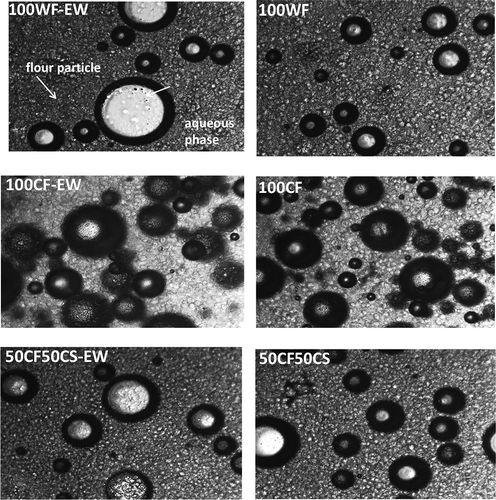Figures & data
Table 1. Codes of batter formulations made at different CF:CS ratios with and without added EW.
Table 2. Two-way mixed-analyses of variance on the oscillatory and steady rheological properties, and on the particle size statistics of gluten-free muffin batters at 25°C (main effects: egg white (EW) and chickpea flour:corn starch (CF:CS) ratio. F and P values.
Figure 1. Effect of egg white (EW) and chickpea flour:corn starch (CF:CS) ratio on the limit values of linear viscoelastic (LVE) range of the gluten-free muffin batters as compared to gluten wheat flour (WF) muffin batter at 25°C; (a) σmax: critical stress amplitude, (b) γmax: critical strain amplitude. a,bFor each rheological property and for the same CF:CS ratio mean values without the same letter between batters with and without incorporated EW are significantly different (P < 0.01). A–EFor each rheological property and the same EW level mean values without the same letter are significantly different (P < 0.01). Values are given as mean (n = 9) ± SD.
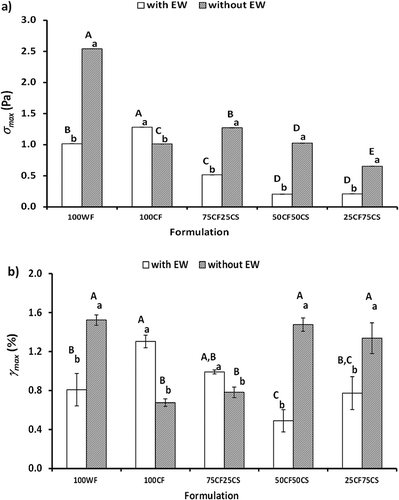
Figure 2. Elastic (G’) and viscous (G”) moduli as a function of frequency for the muffin batters formulated with the different selected CF:CS ratios at 25°C; (a) 0:0 ratio, (b) 100:0 ratio, (c) 75:25 ratio, (d) 50:50 ratio, and (e) 25:75 ratio (closed symbols: G’, opened symbols: G”). For all graphs, triangles represented batters with egg white (EW) and squares batters without EW. Values are given as mean (n = 9) ± SD.
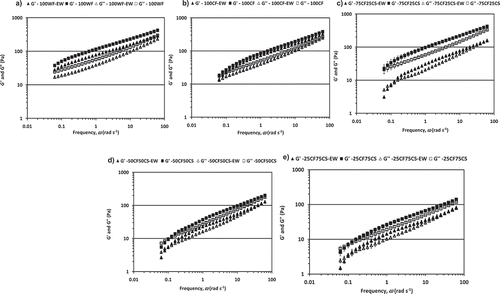
Table 3. Effect of egg white (EW) and chickpea flour:corn starch (CF:CS) ratio on the mechanical spectra of the gluten-free muffin batters as compared to gluten wheat flour (WF) muffin batter at 25°C.
Figure 3. Flow behaviour for the muffin batters formulated with the different selected CF:CS ratios at 25°C; (a, f) 0:0 ratio, (b, g) 100:0 ratio, (c, h) 75:25 ratio, (d, i) 50:50 ratio, and (e, j) 25:75 ratio; (a-e) flow behaviour before shearing; (f-j) flow behaviour after shearing; (closed symbols: upstream data points, opened symbols: downstream data points). For all graphs, triangles represented batters with egg white (EW) and squares batters without EW. Values are given as mean (n = 9) ± SD.
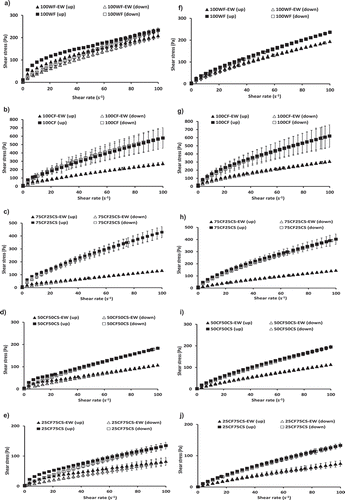
Table 4. Effect of egg white (EW) and chickpea flour:corn starch (CF:CS) ratio on the steady rheological properties of the gluten-free muffin batters as compared to gluten wheat flour (WF) muffin batter at 25°C.
Figure 4. Particle size distribution of the muffin batters formulated with different selected CF:CS ratios (0:0, 100:0, and 50:50) with and without incorporated egg white (EW).
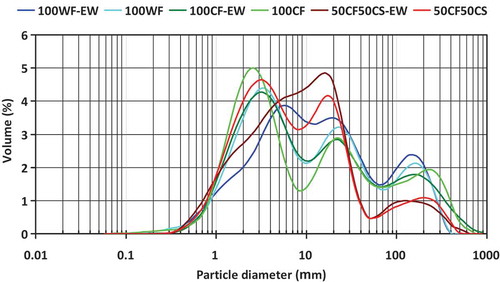
Table 5. Effect of egg white (EW) and chickpea flour:corn starch (CF:CS) ratio on the particle size statistics of the gluten-free muffin batter as compared to control wheat flour (WF) batter at 25°C.
Table 6. Effect of type flour on functional properties.

